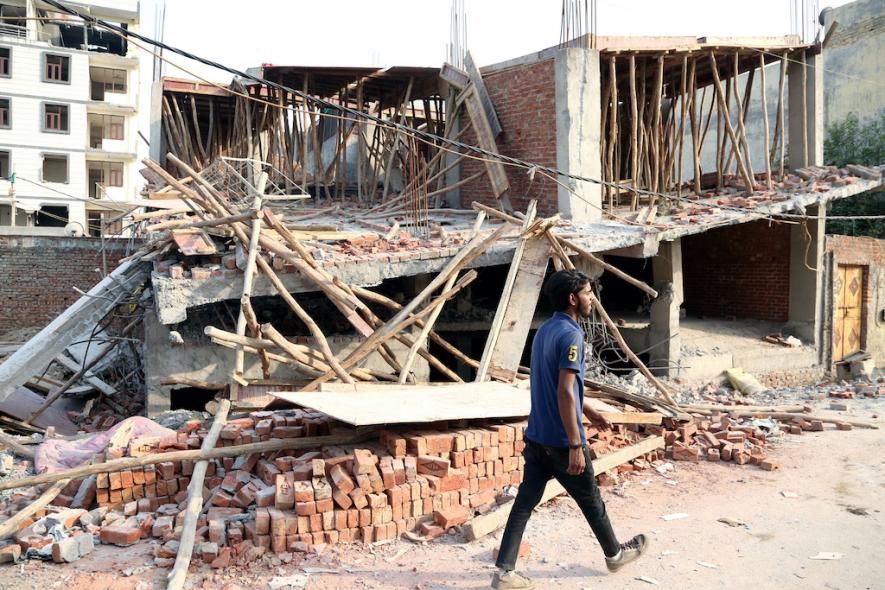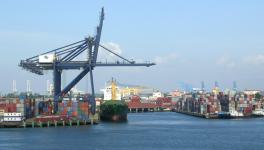Rich Look on as Homes of the Poor Vanish in Delhi

A man walks past demolished structure after a demolition drive in Delhi
In American novelist Kurt Vonnegut Jr.’s novel ‘The Sirens of Titan’, a central character named Winston Niles Rumfoord acquires the power to appear anywhere on earth and then disappear to another planet. One of his sojourns takes him to Saturn’s largest moon, Titan. Vonnegut fantasises that Rumfoord and his dog have entered a phenomenon he calls Chrono-Synclastic Infundibulum, which turns them into a kind of ‘wave’ that appears and disappears at will. Rumfoord materialises—becomes visible—when the scattered molecules of his body come together. And when he wants to disappear from anywhere, the molecules break up, and he dematerialises to materialise in a new location.
The wealthy and middle-class people who live in big metros and cities also want people with fewer resources, who work in their homes, shops, factories, businesses, etc., to appear at their place of work on time, work properly, and then disappear. They expect workers to be diligent and efficient in accomplishing their tasks quickly and appropriately. These sections also believe they pay these workers a lot of money, which they do not even deserve. In a way, they think they are being kind to an underserving lot. It does not matter to them where or how these workers live, whether they have access to health and education or social security. The rich and middle class remain silent and indifferent to all such concerns.
The question is, where should these workers live? Like in Vonnegut’s imaginary world, they cannot materialise and dematerialise at will. They are not characters in a novel but human beings in flesh and blood who live in a cruel real world. With the kind of wages they earn, very few of them can afford houses with concrete roofs. So, where do the rest of them live? Of course, in unhealthy, unsafe, and socially undesirable environs called “slums”.
Their spaces are cramped, yet they live there—entire families of five, six, or seven members in just a tiny hovel. Many pay rent to live in these huts. Even this is termed as “illegal occupation” and “encroachment”. There are times when their settlements are legalised, and at other times, they are bulldozed. It depends entirely on the will of the rulers, the administrators, and the balance of political power. Is it not pertinent to ask, when do the workers figure in our collective understanding or our social and economic discourses?
Look at the residential colonies of the wealthy and the middle class. There is no space for the poor and the underprivileged in them. No part of these colonies is reserved for housing for the workers, as the land prices here are high. When the price of land is steep, men with fewer resources get dwarfed. Setting aside areas for workers’ dwellings makes no “economic sense” in the development discourse. The claims of the underprivileged inevitably dwarf and disappear before such economic logic. Some large, affluent houses create servants’ rooms, typically tiny single rooms where the help and their entire family are expected to stay, feeling obliged. The servants’ room is considered a big favour to a worker. A worker who lives in such a room with their family must be grateful to the employer and, in return, they make themselves available to the master full-time. Not all workers are fortunate enough to get a room in exchange for their services. This is metropolitan slavery—what else are we going to call it?
The same middle-class thinking informs the architecture and town planning professions. Just like no place is carved out where workers can live in dignity while planning colonies, city planning as a whole also creates no space for them. Occasionally, the government will announce housing for the poor and pigeonhole flats are built for working people. The upper and middle classes quickly lash out at these as a “wasteful” expenditure. As control over the process of urbanisation increasingly passes into private hands, new privately-developed colonies have even less space for workers. In fact, they are entirely missing from these developments.
In the perception of the middle class, workers’ settlements are havens for the filthy, the criminals and those who spread disease. There is no room for such settlements in our beautiful clean cities, opines the middle class. They should be demolished to make way for better buildings, or parks and business facilitation centres.
But what is the economy of the demolitions we are seeing? When any settlement (slum) is demolished, the upper and middle-class people living in its neighbourhood heave a sigh of relief. They rejoice that the “filth” is being removed, even if they need those who live there to work in homes, shops, or factories. Whether the government is giving workers an alternative place to live—is it not the government’s responsibility to provide shelter to the underprivileged?—the upper- and middle-class attitude towards these issues is negative.
The middle class thinks it pays taxes, especially income tax, so it funds the government’s expenses and runs the economy, while all other people are a “burden” on the exchequer. In reality, the millions of underprivileged people contribute to the state exchequer through indirect taxes, which pay for the advancement of the rich and cover the salaries and loans taken by the middle class.
When slums and settlements of the poor are demolished, officials declare they have freed government land worth thousands of crores of rupees from illegal occupation. Such announcements are hailed as a sign of the success of the authorities. They are credited with having benefited the government and civil society by thousands of crores. Only on the margins of some newspapers does it appear that the demolition has left thousands homeless and hurt as many livelihoods. Where will the homeless go to live? Nobody thinks about it.
Even if a rehabilitation plan exists for the poor, it is half-baked and remains stuck in administrative red tape for decades. Often, resettlement sites are miles away from the upper- and middle-class habitations, and even then, they are seen as acts of state benevolence.
In a few years, the city expands, and the upper and middle class approach these settlements. All over again, they start talking about the workers’ settlements as filthy, crowded, ‘sanctuaries of crime’, just like Delhi’s affluent class are talking about Jahangirpuri and other settlements these days.
When it comes down purely to economics, most experts say the government saves thousands of crores through demolitions and removing encroachments. But many experts have brought to our attention the losses incurred when thousands of people are left homeless, with their livelihoods destroyed. Losses from such destructions are far bigger than financial gains derived from amassing some more land.
Governments, political leaders, town planners, financial experts, administrators, and economists should be guided by a humane perspective on urban issues. It is their humanitarian, legal and constitutional duty to think about the poor working people before they order the bulldozing of humble settlements. Only this will make us civilised in the true sense, not the mindset that seeks to uproot workers from their homes. Workers are the water that nourishes the soul of humanity. They are the salt of the earth, the real inheritors and masters of the earth. Governments and society must give them their due share. Only by recognising their share can society move towards a just order and build a nation on the principles of justice, equality, and fraternity. Governments and society must change their outlook towards the working people. This is what our Constitution also says we must do.
Dr Swarajbir is the editor of Punjabi Tribune and a noted playwright. The views are personal. This article is a translation by Navsharan Singh from the original in Punjabi, published with permission from the author.
Get the latest reports & analysis with people's perspective on Protests, movements & deep analytical videos, discussions of the current affairs in your Telegram app. Subscribe to NewsClick's Telegram channel & get Real-Time updates on stories, as they get published on our website.
























